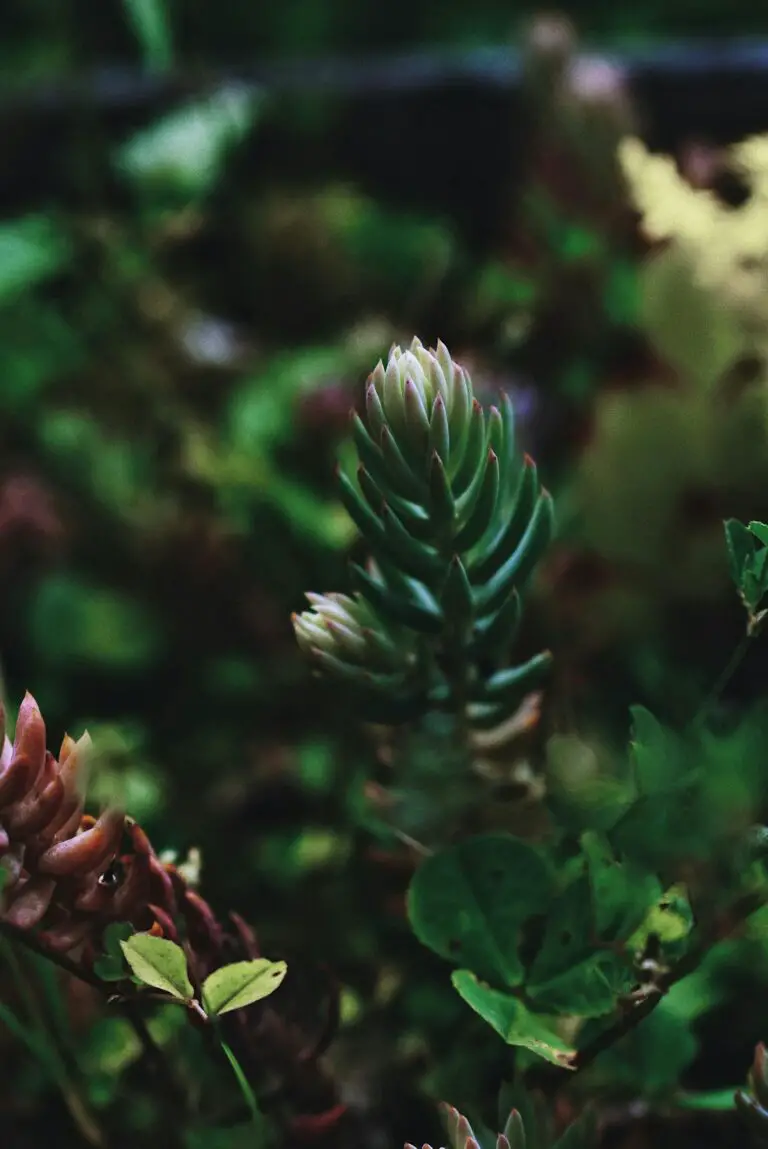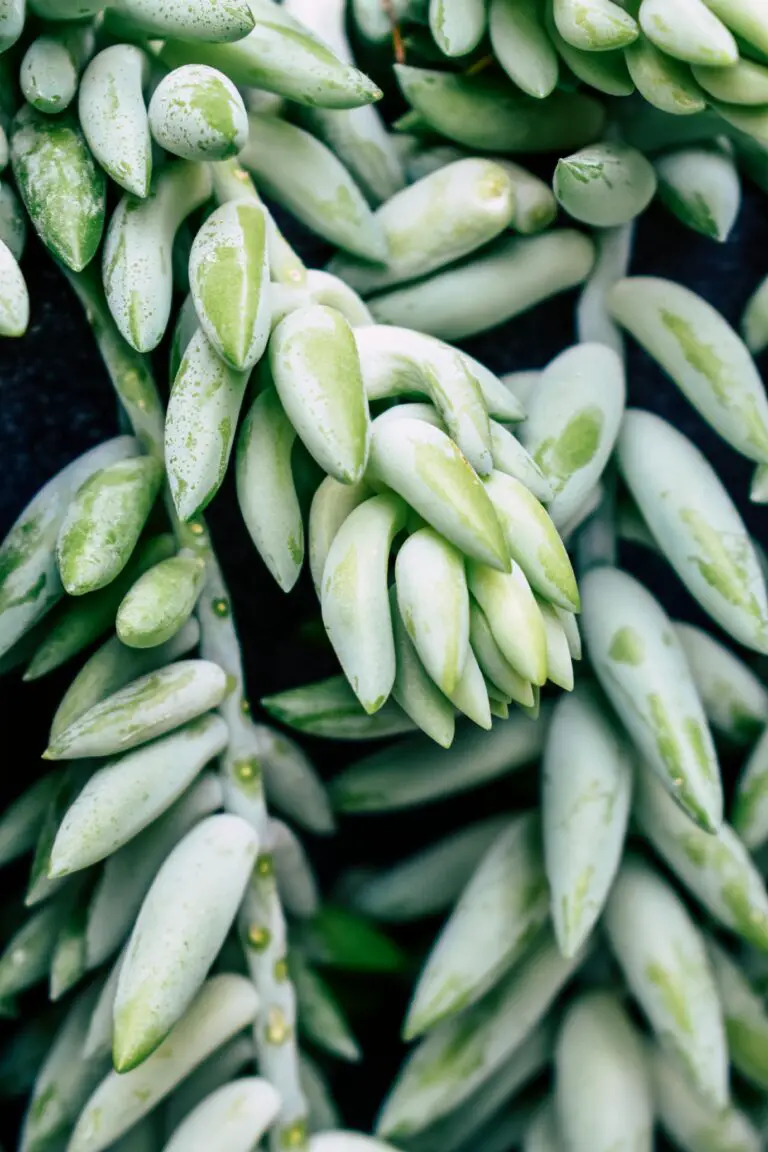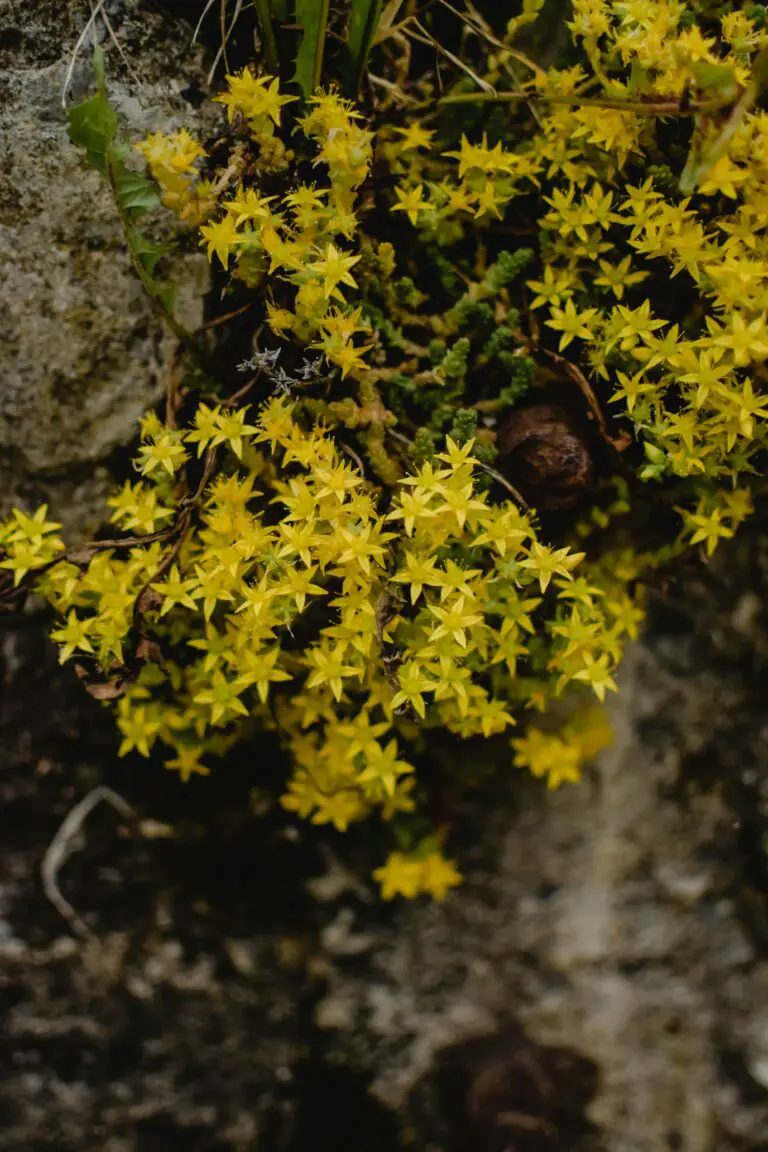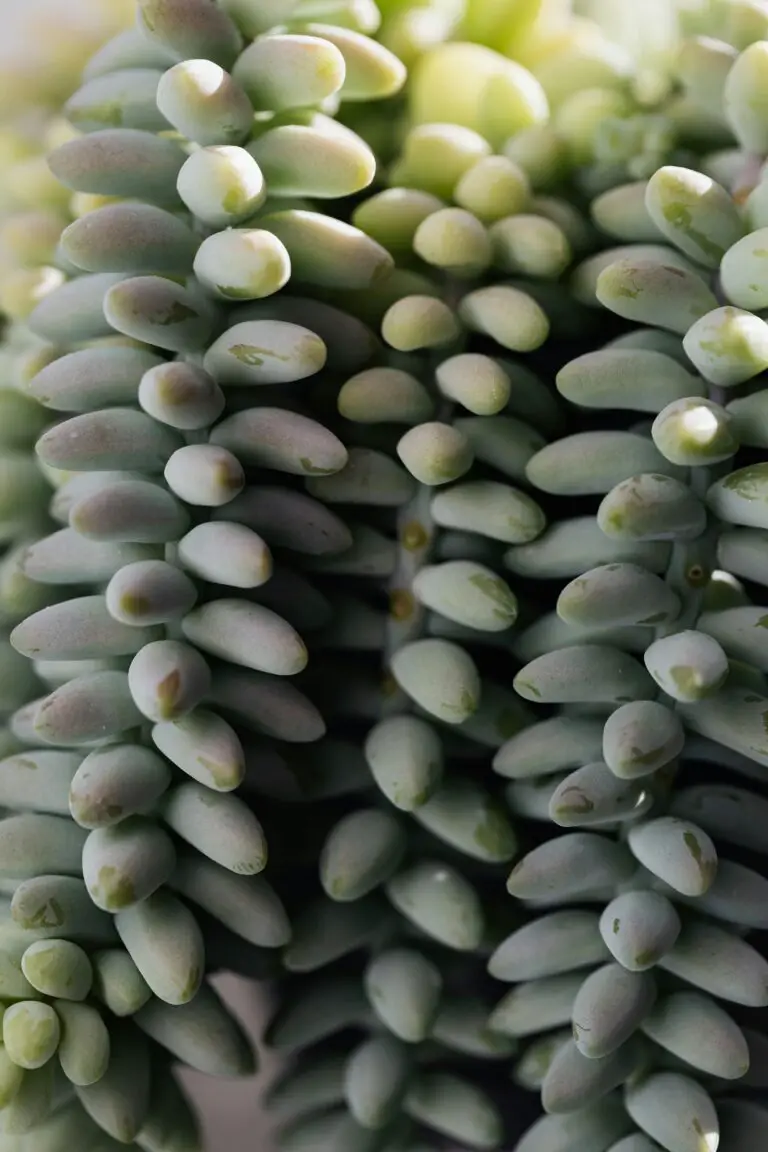Introduction to Fall Sedum Care
As the crisp autumn air sets in, it’s time to pivot our green thumbs to seasonal support for our sedum plants. They’ve spent the summer proudly displaying their verdant foliage and starry flowers, but as the days shorten, these hardy perennials begin a fascinating transformation. Just as squirrels gather acorns in preparation for winter, sedum requires our thoughtful care during this transitional time.
Sedum’s journey through the seasons is a spectacle of nature’s rhythm. Picture the succulent leaves of Sedum ‘Autumn Joy’, turning from a robust green to a deep, bronzed amber. It’s indeed a visual delight, but these changes signal something significant: it’s time to reassess our gardening strategies.

Autumn care for sedum isn’t just about aesthetics; it’s about setting the stage for longevity and health. Just like athletes cool down after a vigorous game, sedum needs to gradually acclimate to the impending cold. Ignoring this phase could mean less vibrancy the following year or, worse, a succulent collection that struggles to survive.
Let’s explore a real-life example. Imagine forgetting to deadhead or trim back your sedum. You might find the once-lush plant now battling the spread of diseases or pests vying for residence among the neglected stems. We certainly don’t want that. Instead, by proactively managing your garden’s ecology, you can ensure sedum thrives amidst the changing seasons.
In essence, tuning into sedum’s natural life cycle as summer turns to autumn is a lesson in plant parenting. It’s about adapting to its needs and respecting its growth patterns. Understanding and embracing this shift is not only vital for sedum’s health but also enriches our own connection with the natural world.
Benefits of Cutting Back Sedum in Fall
As the vivid hues of autumn begin to blanket our gardens, it’s the perfect time to consider the merits of giving your sedum a little pre-winter trim. But why should these robust succulents get a haircut before the frost sets in? The reasons are both aesthetic and practical, offering a promise of rejuvenation for the upcoming year. Picking up the shears in fall can lead to a healthier and more vibrant display come spring.
An untrimmed sedum can look a bit like the aftermath of nature’s own garden party—drooping stems, spent flowers, and all. Trimming back these hardy perennials can prevent the garden from looking unkempt and, more importantly, can help maintain the health and vitality of the plants. A picturesque example of this is the sturdiness of a well-pruned sedum, which can avoid becoming top-heavy and reduce the risk of damage from winter weather.
Cutting back sedum isn’t just a defensive move against the elements. It can also stimulate the plant to focus its energy on the dense, fresh growth that emerges in spring. This is akin to a farmer pruning an apple orchard; the result is a bountiful, lush crop rather than a wild tangle of branches. Similarly, dedicated gardeners understand that strategic snipping can pave the way for a showcase of vigorous blooms when winter’s hold finally wanes.
The photograph below captures the essence of a sedum poised for its fall refresh. One can almost feel the anticipation of new life brimming beneath the surface, waiting for the warmth of spring to unfurl in full splendor.

By embracing the practice of fall pruning, we not only tidy up our garden beds but also set the stage for a pageant of perennial beauty. It’s a moment in the gardener’s calendar that’s as much about preparation and promise as it is about reflection and rest.
The Right Way to Cut Back Sedum
Are you ready to get a little dirty and a lot wise when it comes to your cherished sedum? Pruning these hardy perennials is more of an art than you might think. But don’t worry, you don’t need to be a green-thumbed guru to do it right! Let’s roll up our sleeves and jump into the step-by-step instructions guaranteed to keep your sedum smiling through the seasons.
Timing is Everything
First things first—when should you brandish those shears? The ideal time to prune your sedum is after the first light frost in fall, but before the ground fully freezes. This little timing trick helps your sedum enter dormancy with a neat appearance and ensures a vigorous comeback in spring. It’s almost like your plants are sneaking in a quick nap before the big show next year!
Tools of the Trade
Before you start clipping away, arm yourself with the right equipment. Clean, sharp pruning shears are your best friend here. They’ll give you clean cuts without bruising the stems—a must for keeping your sedum healthy. And oh, don’t forget gloves! Sedum sap can be irritating to some, and besides, who wants a rogue splinter ruining their pruning party?

Prune Like a Pro
Now here’s where the magic happens. Start by identifying the sedum’s base—where the stem meets the soil. Aim for about an inch or two above this point and snip with confidence. You’re looking to remove spent flower heads and any dead foliage; this isn’t a shear-for-sheer-fun scenario. A neat plant is a happy plant, and a happy plant will thank you come blooming time.
But remember, you’re not making a topiary here (unless you’re into that, then you do you). The goal is to encourage growth, not stifle it. Want to see the results of skillful pruning? Check out this guide that showcases sedum’s stunning comeback after a good trim!
There you have it, folks—the CliffNotes version of ‘Sedum Pruning 101.’ Now grab those shears, summon your inner garden warrior, and let those sedum know who’s boss. Just remember to prune with purpose, keep it clean, and always time it right. Happy snipping!
Common Mistakes to Avoid When Pruning Sedum
Caring for your sedum requires precision and patience, especially when wielding the pruning shears. It’s all too easy to get snip-happy and make a cut you can’t take back. To avoid turning your sedum into a gardening cautionary tale, let’s go over some common pruning blunders and how you can steer clear of them.
Overzealous Trimming: Less is More!
Picture this: a crisp autumn day, the leaves are changing, and you decide it’s time to give your sedum a haircut. Hold those shears lightly! Cutting too much can leave your plants vulnerable and unable to store enough energy for winter. Aim to remove just the dead growth and leave the rest to flourish. Remember, sedum plants are like a fine wine—they only get better with time and a gentle touch.

Timing Troubles: Know When to Pause
Have you ever decided to prune just because you had a free afternoon? Timing is everything with sedum. Pruning too early or too late in the season can impact next year’s growth. The sweet spot? After the flowers fade but before the frost sets in. This is when your sedum whispers, “It’s time for a trim!” Listen to nature’s cues, not the gaps in your calendar.
The Wrong Tools: Not All Shears are Created Equal
Using blunt or dirty tools isn’t just ineffective—it’s a free ticket to Pest and Disease City. Always use sharp, clean shears to make precise cuts. Dull tools can damage the stems, leaving them ragged and more susceptible to problems. It’s equivalent to cutting your own hair with kitchen scissors—just don’t do it!
Pruning for Perfection: Embrace Nature’s Imperfections
Perfection is a myth, especially in the garden. Sedum has a natural, wild beauty that doesn’t need to be sculpted into submission. Instead of aiming for a manicured masterpiece, focus on enhancing its innate charm. A little asymmetry here and there? That’s nature’s artistry at work. Let those quirks thrive, and you’ll see how they contribute to the overall allure of your garden.
By evading these common errors, you’ll guide your sedum through autumn with ease. With preventative advice tucked into your gardener’s toolkit, you’re all set to nurture a thriving, resilient sedum that’s ready to burst back into life come spring.
Prepping Your Sedum for the Cold: Protective Measures
Snip-snip, there go the dead stems! But wait, your sedum isn’t in the clear just yet. With the chill of fall sweeping in like an uninvited guest, it’s time to roll up those sleeves and take some additional steps to ensure your garden’s resilience against Jack Frost’s embrace. Let’s dive into some nifty post-pruning practices to winter-proof your beloved sedum.
Imagine you’re tucking your green buddies in for a long winter nap. Reach for that pile of mulch like it’s a cozy blanket—because for your plants, it kind of is. A gentle layer of mulch acts as an insulator, keeping the soil temperature steady and protecting roots against freeze-thaw cycles that can heave and harm them. Sprinkle around but not directly touching plant bases; think of it as fluffing the perfect pillow around them, not smothering them. It’s a simple act, but your sedum will thank you by springing back to life with vigor when the sun returns.
Next on the list, hydration. “But winter’s wet,” you say? Ah, but those crystal-clear ice and snow can be deceiving. Dry cold spells are a sneaky threat to your sedum’s grand comeback. Watering before the ground freezes can provide your sedum with a much-needed drink to tide it over until the spring thaw. It’s like leaving a water bottle by your bed at night; it’s there when you need it. The key is to give them a good soak, encouraging deep roots that are better insulated against the cold.

For more year-round garden maintenance tips, you might like to explore our guide on how Crassula Ovata can thrive outdoors. Prepping your sedum now might just be the ticket to witnessing your garden’s full potential, regardless of what the seasons throw its way.
Remember, while winter is nature’s time for rest, it doesn’t have to mean total dormancy for your garden efforts. By following these simple steps, you’re setting the stage for a spring full of blossoms and growth. Just imagine those first green shoots pushing through the last snow, a testament to your tender care during the colder months. A healthy sedum in spring starts with the love and protection you provide in the fall.
To Cut or Not to Cut: Pros and Cons
As the amber hues of fall drape themselves over the garden, the question arises: should I cut sedum back in the fall? Sedum, with its resplendent fleshy foliage and starry flowers, has sparked a debate among green thumbs and gardening aficionados alike. The decision isn’t clear-cut, and it often boils down to a gardeners’ duel with scissors poised: to chop or not to chop?
On one hand, proponents for giving your sedum a trim before winter argue the act can prevent rot and disease. Imagine a wet, snowy winter—sedum’s lush carpet turns into a soggy mess, creating a perfect breeding ground for fungi. Cutting back helps to avoid this dismal outcome, allowing the plant to return with vigor in spring. It’s the horticultural equivalent of a fresh start and is particularly favored in regions where winter is more of a soggy affair than a snowy spectacle.
However, let’s flip the shears and consider the contrarians who believe in letting nature run its course. Allowing sedum to stand tall through winter can offer numerous benefits. Not just a wintry aesthetic of frost-kissed blossoms, but a refuge for beneficial insects and birds. And as the winter wanes, the dried stems can create natural insulation, shielding the crowns from bitter cold snaps—especially important in harsher climates where Mother Nature’s icy breath is less forgiving.
Likewise, the question of whether to cut back sedum shouldn’t be taken lightly. Every snip could shape the future blooming season. For instance, a gardener living in the Pacific Northwest—where rain is as common as a cup of coffee—might lean towards cutting back. On the contrary, in the northern reaches of the Midwest where winters are fierce, letting sedum stand could prove as a knight’s shield for the plant’s tender roots.
To drill down to a verdict in this back-and-fourth debate, consider your local climate as the gavel. If your fall consists of persistent dampness and mildew is a known adversary in your garden, a strategic trim could be your best defense. Conversely, if your winters are more Narnia than Neverland, leaving your sedum be could be the magic that ushers it safely into spring.
Real-life examples abound in gardening communities, with tales of sedum revival following a judicious fall cut-back, or untouched plants springing to life after a snow-blanketed hibernation. There isn’t a one-size-fits-all answer, which makes gardening the ever-engaging puzzle that tantalizes with every season’s change.
As you ponder over your sedum’s fate, take a moment to appreciate the tenacity of these hardy perennials. Their ability to stir such passion in the hearts of gardeners is a testament to their charm, and whether snipped or spared, they remain a jewel in the crown of fall gardening.

Expert Tips: Maximizing Sedum Health Post-Trim
If you’re wondering “should I cut sedum back in the fall?” you’ve likely already taken the shears to these robust perennials. But what comes next? Let’s unpack the steps to ensure your sedum doesn’t just survive but thrives after a fall trim. Remember, post-trim care is crucial for maintaining plant health and vigor.
First things first, let’s address the immediate aftermath. Your sedum’s been trimmed; now it’s time to protect it from opportunistic pests seeking to exploit those fresh cuts. Think of it like sealing a wound to prevent infection. A great way to do this is by applying a natural repellent, such as neem oil, to deter common garden pests like aphids and mealybugs. Imagine, it’s like arming your plants with an invisible shield!
Next on your to-do list is fertilization. Imagine your sedum as an athlete who’s just finished a rigorous workout—that’s essentially what trimming is for plants. It depletes them. Just as athletes need to refuel, your sedum needs a burst of nutrition to bounce back stronger. Apply a well-balanced, slow-release fertilizer that’s suited for succulents. This will replenish essential nutrients and promote robust growth. It’s like a nutrient-packed smoothie for your garden dwellers!
An anecdote to illustrate: I once nursed a bedraggled sedum back to its lush, pre-trim glory by following these simple yet powerful tips. A touch of pest prevention and a dash of timely fertilization turned what seemed like a gardening misstep into a success story. Your sedums, too, can be the envy of the neighborhood with a little TLC after their fall haircut.
Let’s not forget the visuals. Here’s a splendid image of a trimmed sedum bracing for the cooler months, an emblem of resilience and preparation. You too can ensure your sedums are picture-perfect with the right post-trim care.

Encapsulating this advice, think of post-trim care as setting the stage for your sedum to perform gracefully into the next season. With these expert insights, you’re more than ready to give your garden the boost it needs after a fall trim. Happy gardening!
Frequently Asked Questions
Got a green thumb quandary about whether to snip or not to snip your sedum this fall? We’ve dug up the dirt on everything you need to know! Let’s get those questions answered:
Should I cut back my sedum in the fall?
The short answer is, it depends. While sedum, also known as stonecrop, is quite the hardy trooper, tidying them up in the fall can encourage healthier growth in the spring. Imagine giving your sedum a cozy little blanket of its foliage to keep it snug over winter.
What’s the best method to cut back sedum?
It’s as simple as grabbing your shears and channeling your inner hairdresser. Aim to snip about a third of the plant, cutting just above a leaf node or bud. Think of it as giving your sedum a stylish trim rather than a drastic haircut.
Will my sedum thrive better if left uncut until spring?
Leaving the stems tall throughout the winter can create a striking silhouette in your frosty garden, and some gardeners swear by this method for added protection against the cold. Plus, those dried flower heads look simply enchanting with a dusting of snow!
Any tips for sedum care during colder months?
Ah, sedum care in the chill – avoid watering it as much as you would during its growing season. And make sure it’s not sitting in any soggy soil; these succulent superstars prefer it on the dry side.
For a visual guide on caring for your sedum, check out this helpful video:
How does trimming sedum impact its blooming the following year?
Picture this: it’s next spring, and your sedum bursts to life with more vim and vigor than ever, thanks to that fall cleanup. Give it a trim, and you might just notice busier bees around your beefier blooms!
Can cutting back sedum in the fall help with pest control?
Absolutely! Chop those dead stems down, and you’ll be slashing the chances of pests bunking down for the winter. It’s like telling uninvited critters the hotel’s closed till spring!
Any final fall care tips?
Give your sedum a good once-over before the frost sets in. Remove any damaged or diseased parts, which is like sending your plant to winter with a clean bill of health. That way, it’s all systems grow when the warmth returns!
Remember, every sedum has its day, and with these tips, you’ll ensure yours has plenty of good ones ahead!



